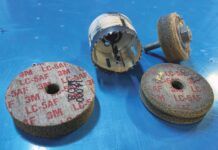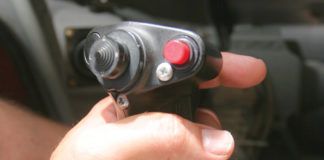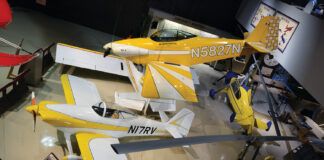KITPLANES Magazine, June 1999
Aero ‘lectrics
Back to Basics; Get to Know the Parts.
by Jim Weir
Over the last couple of years, while trying to figure out how to make cheap speaker and headphone amplifiers, minimal cost intercoms, and the ever-popular idiot light series, I’ve received more than a hundred e-mails asking, “What transistor should I use?” or “Where do you get a left-handed pilfer grommet?”
As there seems to be a lot of confusion on not only parts and their sources, but on the layout of the part itself, it’s time to take a deep breath and talk about components themselves rather than the next circuit in line.
Instead of giving you an outline drawing with each article, this column will be the reference page for all my circuits of the past few years and in the years to come unless there is a special part that I draw with the article. This will allow you to make up a parts list of your own when you go to buy the parts for any of my articles; in electronikspeak this is sometimes called a bill of materials–a BOM for short.
Parts Sources
I know a lot of good parts places in Sacramento and the San Francisco Bay Area and a few more in my old stomping grounds in San Diego, but I don’t have a clue where to buy stuff where you live.
Rather than leave readers in the lurch, I’m only going to deal with those folks that I know will sell mail order, that have a catalog they will send you free, and (possibly most important) will sell ones and twos of parts instead of the normal “How many thousand would you like?” a wholesale parts house would ask. You might pay a couple of bucks more per project, but you can pretty well bet that the parts you buy will be the same parts I’m using in the prototype. And by using mail order, you have an order of magnitude more freedom to select parts over your local Radio Shack store as well as knowing that the parts will generally cost less than half of retail prices.
Here are the two parts sources I recommend:
Mouser Electronics (800/346-6873) or online ordering at http://www.mouser.com/
(warehouses in California, Texas and New Jersey).
Digi-Key Electronics (800/344-4539) or online ordering at http://www.digikey.com/
(Minnesota).
While I tend to specify Mouser when I can, both for price and variety, there are some things (like Panasonic parts and a lot of single-purpose integrated circuits) for which Digi-Key is the only source. I will specify part numbers for both of these sources where I can. I will also give the Radio Shack part number if you just can’t wait a couple of days to get it by mail.
Resistors and Capicitors
Unless otherwise specified, I use carbon film 1/4-watt 5% resistors. For capacitors below 1000 pf, I generally use a disk ceramic. Between 1000 pf (0.001 uf and 0.1 uf) [uf = microfarad], I use a green Mylar “jellybean” capacitor, and above 0.1 uf I use aluminum electrolytics.
The only caveat about these parts is that electrolytic capacitors have a polarity and must be installed in the right direction. Generally it is only the minus (-) end of the capacitor that is marked.
Table 1 shows the part numbers of the series of parts I use for resistors and capacitors.
Transistors and Diodes
When I forget and write that “any NPN transistor” will work, I’ve come to understand that the morning after the issue comes out, there will be the usual “What NPN transistor do you recommend?” question in my e-mail. For the answer, check Table 2 (and keep it for reference).
All transistors and diodes have a polarity, a way they need to be connected into the circuit. Figure 1 shows how to identify the leads on these parts.
Table 2. Transistor part numbers.
Integrated Circuits
I use two favorite linear integrated circuits because they are almost bulletproof, and they are very reliable. One is an op-amp and the other is a low-power audio amplifier. See Figure 3.
As you probably know, integrated circuits need to be installed in a particular orientation. The problem with an integrated circuit is to figure out which is Pin 1. After that, it is a simple matter to count from Pin 1 clockwise (looking at the bottom of the package) to the pin you intend to use. Again, a picture is worth a kiloword; Figures 2 and 3 show the LM324 and LM386 pinouts.
The Case is Closed
After all is said and done, we need some box or other structure to enclose the project to keep the nasties out of the innards. Somehow an aluminum drill shaving always manages to land dead center on the most sensitive, expensive component when the works are left exposed to the world.
Here there is no contest. The Radio Shack 270-180x series wins hands-down. They are less than half the cost of boxes from “the other guys” and come in eight handy sizes.
Likewise, you can’t play with these circuits unless you have some sort of breadboard for mounting parts while experimenting. I recommend the Radio Shack 276-169. This is the standard “diddleboard” that has been used for my company projects for the last 20 odd years. Actually, only some of the years were odd. Some were pretty good.
That’s about it for this month. As I promised last month–before I got switched on to this BOM idea by a few dozen e-mails begging for parts information–we’re going to do an overwinter battery charger with some pretty nice bells and whistles. And guess what? Most of the parts are going to come from the tables in this month’s column.
AUTHOR JIM WEIR is the chief avioniker at RST Engineering. He can be reached by e-mail at [email protected] but prefers to answer questions in the newsgroup rec.aviation.homebuilt.














